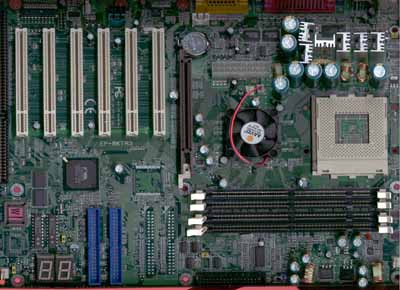EPoX EP-8KTA3 Socket-A KT133A ATX
by Mike Andrawes on January 25, 2001 4:48 PM EST- Posted in
- Motherboards
Shouldn’t it look like the EP-8KTA2?
As we mentioned in the KT7A-RAID review, the migration from KT133 to KT133A shouldn’t be a lot of work. If a manufacturer did a decent job in designing the KT133 solution, running the same board with KT133A chipset should be no problem.
However, when we first looked at the EP-8KTA3, we immediately noticed that the layout of the board is quite different from its brother. EPoX has made quite a few changes in the placement of capacitors, IDE connectors, South Bridge, and a lot of other components. The size of the board is a little bit larger than the EP-8KTA2, measuring in at 12 by 9.5 inches. Does this mean that the old design is not able to sustain the faster FSB speed?
While we cannot confirm this, one thing is for sure: the new design definitely makes the motherboard more stable than the old one. Moreover, as we will mention later in the review, some of the new features of the EP-8KTA3 might require changes in the layout.
Unfortunately, the layout design around the CPU socket might affect the overall cooling of the system. As you notice, all the capacitors and voltage regulators are tightly packed with each other on top of the CPU socket. There are two problems with this design. For starters, the capacitors are quite tall and the voltage regulators are actually mounted to heat sinks vertically, which can seriously affect the airflow around the CPU socket. Secondly, during our testing we found that these capacitors and voltage regulators got quite hot, and that can also affect the cooling of the CPU socket.

All the capacitors and voltage regulators are crowded around the socket.

Notice how close the capacitors are to the HSF unit.
Moreover, the power supply connector is placed to the left of the capacitors. This means the power cables will have to run over the CPU and possibly the capacitors and voltage regulators, which could create another obstacle for the airflow. Last of all, the DIMM slots are very close to the CPU socket, so when the memory is in place, it might also block the airflow.

The memory is very close to the HSF unit.
With recent 1.2GHz Athlon processors dissipating around 60W of heat, you have to be very careful in using the EP-8KTA3 and make sure that there is no overheating. Also notice that some of the capacitors are relatively close to the CPU socket; therefore, make sure your HSF unit can fit without any problems.
The placement of the two IDE controllers might take up quite some space, so you will not be able to put in long PCI devices on third and fourth PCI slots. This get worse with the RAID version of the motherboard, the EP-8KTA3+, where the extra two IDE controllers will block the first and second PCI slots as well.











0 Comments
View All Comments